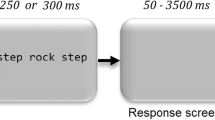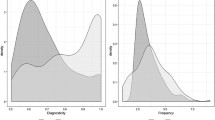Abstract
The present investigation examined developmental changes in the “automatic” use of context in single word recognition. A modified Stroop procedure was used in which children were asked to name the color of the ink of target words. The target was preceded either by a semantically related or by an unrelated word. Results suggested that, in contrast to “attentional” context effects (Pring and Snowling 1986), the older readers showed significantly more influence from the semantic context than the younger, less-proficient readers. The results are discussed with reference to the connections between a novice reading system and a child's rapidly growing semantic memory system.
Similar content being viewed by others
References
Clark, M. m. 1974 Young Fluent Readers. London: Heineman.
Goodman, K. S. 1973. Psycholinguistic universals in the reading process. In F. Smith (ed.), Psycholinguistics and Reading, New York: Holt, Rhinehart & Winston.
Healy, J. M. 1982. The enigma of hyperlexia. Reading Research Quarterly, 17, 319–338.
Merrill, E. C., Sperber, R. D. and McCauley, C. 1981. Differences in semantic encoding as a function of reading comprehension skill. Memory & Cognition, 9, 618–624.
Morton, J. 1970. Interaction of information in word recognition. Psychological Review, 76, 165–178.
Perfetti, C. A. and Hogaboam, T. W. 1975. Relationship between single word decoding and reading comprehension skill. Journal of Educational Psychology, 67, 461–469.
Posner, M. I. and Snyder, C. R. R. 1975. Attention and cognitive control. In R. L. Solso (ed.), Information Processing and Cognition. The Loyola Symposium, Hillsdale, N.J.: Lawrence Erlbaum.
Postman, L. and Keppel, G. 1970. Norms of Word Associations. New York: Academic Press.
Pring, L. 1984. A comparison of word recognition processes of blind and sighted children. Child Development, 55, 123–162.
Pring, L. and Snowling, M. 1986. Developmental changes in word recognition: an information-processing account. Quarterly Journal of Experimental Psychology, 38A, 395–418.
Schvaneveldt, R., Ackerman, B. P. and Semlear, T. 1977. The effect of semantic context on children's word recognition. Child Development, 48, 612–616.
Schwantes, F. M. 1981. Locus of the context effect in children's word recognition, Child Development, 52, 895–903.
Simpson, G. B., Lorsbach, T. C. and Whitehouse, D. 1983. Encoding and contexual components of word recognition in good and poor readers. Journal of Experimental Child Psychology, 35, 161–171.
Snowling, M. and Frith, V. 1986. Comprehension in “hyperlexic” readers. Journal of Experimental Child Psychology, 42, 392–415.
Stanovich, K. E. 1980. Toward an interactive-compensatory model of individual differences in the development of reading fluency. Reading Research Quarterly, 16, 32–71.
Warren, R. E. 1972. Stimulus encoding and memory. Journal of Experimental Psychology, 94, 90–100.
West, R. F. and Stanovich, K. E. 1978. Automatic contextual facilitation in readers of three ages. Child Development, 49, 717–727.
Author information
Authors and Affiliations
Rights and permissions
About this article
Cite this article
Pring, L., Snowling, M. The ‘automatic’ use of context in children's reading. Read Writ 1, 53–60 (1989). https://doi.org/10.1007/BF00178837
Issue Date:
DOI: https://doi.org/10.1007/BF00178837




